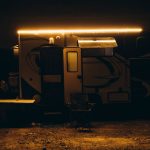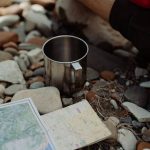Male Vandergrift
RV Life: How to Stay Organized in a Small Space
RV Life: How to Stay Organized in a Small Space
Living the RV life can be an exhilarating adventure, offering the freedom to explore new places while bringing the comforts of home along for the ride. However, one of the biggest challenges RV enthusiasts face is staying organized in such a compact space. 🚌✨ Whether you’re a seasoned nomad or a newbie on the road, these tips will help you maximize your RV’s potential and keep things tidy.
Table of Contents
1. Embrace Minimalism
2. Smart Storage Solutions
3. Multifunctional Furniture
4. Routine Cleaning Habits
5. Add Personal Touches
Embrace Minimalism
The first step to staying organized in an RV is to adopt a minimalist mindset. Ask yourself: “Do I really need this?” before bringing anything on board. 🌱 Less truly is more when it comes to RV living. Focus on items that serve multiple purposes or are essential for your day-to-day life. This approach not only reduces clutter but also makes it easier to find what you need when you need it.
Smart Storage Solutions
Space is a premium in any RV, so getting creative with storage is key. Consider these ideas:
Vertical Storage: Utilize wall space with hanging organizers, magnetic strips for spices, or hooks for kitchen utensils.
Under-Bed Storage: The space beneath your bed is perfect for storing out-of-season clothes or bulky items. Use storage bins or vacuum-sealed bags to keep things tidy.
Collapsible Containers: Opt for collapsible kitchenware and storage containers that can be easily tucked away when not in use. 🍽️
Multifunctional Furniture
Furniture that serves more than one purpose is a lifesaver in an RV. Consider investing in a dining table that doubles as a workspace or a sofa that converts into a guest bed. These pieces can help you make the most of every square inch without sacrificing comfort or style. 🛋️
Routine Cleaning Habits
Maintaining cleanliness in an RV is crucial to staying organized. Make it a habit to clean as you go, ensuring that dishes are washed promptly and surfaces are wiped down regularly. Establish a daily or weekly cleaning schedule to keep things from piling up. A clean RV feels more like a home and less like a cramped space. 🧼🧹
Add Personal Touches
While organization is essential, don’t forget to make your RV feel like home. Add personal touches like family photos, favorite books, or small plants to create a cozy atmosphere. 🌿 This personal touch will not only enhance your living space but also make it feel more inviting.
Conclusion
Staying organized in an RV doesn’t have to be a daunting task. By embracing minimalism, utilizing smart storage solutions, investing in multifunctional furniture, and maintaining a routine cleaning schedule, you can enjoy a clutter-free and comfortable RV lifestyle. Remember, the key is to make the most of your space while infusing it with personal touches that make it feel like home. Happy travels! 🚐✨
FAQs
Q: How can I declutter my RV effectively?
A: Start by sorting items into keep, donate, and discard piles. Focus on keeping essentials and items you use regularly. Consider digital alternatives for books or documents.
Q: What are some must-have storage items for an RV?
A: Must-have storage items include collapsible containers, under-bed storage bins, hanging organizers, and magnetic strips for maximizing wall space.
Q: How often should I clean my RV?
A: Aim for routine cleaning daily, like doing dishes or wiping surfaces. A deeper clean can be scheduled weekly to keep the space fresh and organized.
Q: Can I personalize my RV without adding clutter?
A: Absolutely! Use small, meaningful items like photos or compact decor to add personality without overwhelming the space.
How to Choose the Best RV for Your Retirement
How to Choose the Best RV for Your Retirement
Retirement is a time to embrace freedom, explore new horizons, and maybe even hit the open road! If you’ve been dreaming of traveling in an RV during your golden years, you’re not alone. But with so many options out there, finding the perfect RV for your retirement can be overwhelming. Fear not, adventurers! This guide will help you navigate the choices and find the best RV to suit your needs.
Table of Contents
1. Understanding Your Travel Needs 🚐
2. Types of RVs: Which One is Right for You?
3. Key Features to Consider
4. Budgeting for Your RV Purchase 💰
5. Conclusion
6. FAQs
Understanding Your Travel Needs 🚐
Before diving into the world of RVs, take a moment to think about your travel plans. Are you planning short weekend trips, or do you envision cross-country adventures? Consider these factors:
Travel Frequency: How often do you plan to hit the road?
Travel Companions: Will you be traveling solo, with a partner, or bringing along family and friends?
Preferred Destinations: Are you drawn to national parks, beaches, or urban areas?
Understanding your travel style will help narrow down the type of RV that’s best for you.
Types of RVs: Which One is Right for You?
RVs come in various shapes and sizes, each with its own set of advantages. Here are some popular options:
Class A Motorhomes
These are the largest and most luxurious RVs. Perfect for those who want all the comforts of home on the road. Ideal for long-term travel but can be challenging to maneuver in tight spaces.
Class B Motorhomes (Campervans)
Compact and easy to drive, these are great for adventurous retirees who prioritize mobility and are comfortable with less living space.
Class C Motorhomes
A middle ground between Class A and B, offering more space than campervans but easier to handle than Class A. Perfect for families or those who want a balance of comfort and convenience.
Travel Trailers and Fifth Wheels
If you already own a truck, these towable options offer flexibility and cost savings. They vary greatly in size, so you’ll find something that fits your lifestyle and budget.
Key Features to Consider
Once you’ve narrowed down the type of RV, it’s time to think about the features that matter most to you:
Living Space: Consider the floor plan and how it fits your needs for sleeping, cooking, and lounging.
Storage: Evaluate the available storage for your belongings and gear.
Fuel Efficiency: Keep in mind that larger RVs typically consume more fuel.
Accessibility: Look for features like easy entry steps and user-friendly controls.
Budgeting for Your RV Purchase 💰
Your RV adventure should start with a clear budget in mind. Consider these costs:
Initial Purchase Price: Prices can range from a few thousand to a few hundred thousand dollars depending on the type and features.
Maintenance and Repairs: Regular upkeep is essential for longevity and safety.
Insurance: Shop around for the best coverage options for your needs.
Travel Expenses: Factor in fuel, campsite fees, and other travel-related costs.
Conclusion
Choosing the best RV for your retirement is an exciting decision that can open the door to countless adventures. By understanding your travel needs, exploring different types of RVs, and considering key features and budgets, you’ll be well on your way to finding the perfect home on wheels. Here’s to your next great adventure! 🌟
FAQs
Q: What is the best RV for full-time living in retirement?
A: Class A motorhomes are popular for full-time living due to their spaciousness and luxury amenities.
Q: How much does it cost to maintain an RV annually?
A: Annual maintenance costs can range from $1,000 to $3,000, depending on the RV type and usage.
Q: Can I finance an RV like a car?
A: Yes, many lenders offer RV financing options similar to auto loans, with varying terms and interest rates.
RV Life: Tips for Solo Travelers
RV Life: Tips for Solo Travelers
Embarking on a solo RV adventure is an exhilarating experience that offers freedom and self-discovery. Whether you’re a seasoned nomad or a newbie hitting the road for the first time, RV life as a solo traveler comes with its unique set of challenges and rewards. In this guide, we’ll explore practical tips and insights to help you make the most of your solo journey. Let’s dive in! 🚐✨
Table of Contents
1. Safety First: Your Top Priority
2. Planning Your Route: Flexibility Meets Strategy
3. Staying Connected: Tech Tips for the Road
4. Embracing Solitude: Making the Most of Alone Time
5. Conclusion: Your Adventure Awaits
6. FAQs
Safety First: Your Top Priority 🛡️
Traveling solo means you’re solely responsible for your safety. Here are some key tips to ensure a secure journey:
1. Trust Your Instincts: Always listen to your gut feeling. If a place or situation doesn’t feel right, it’s okay to move on.
2. Share Your Itinerary: Keep family or friends informed of your travel plans. Regular updates on your whereabouts can be a lifesaver.
3. Keep Emergency Supplies: Stock up on essentials like a first aid kit, flashlight, and basic tools. Having these within reach can make a big difference in unforeseen circumstances.
Planning Your Route: Flexibility Meets Strategy 🗺️
While spontaneity is part of the RV charm, a little planning goes a long way in enhancing your solo adventure:
1. Map Out Stops: Identify key stops for fuel, food, and rest. Apps like Google Maps and AllStays can be invaluable for finding RV-friendly locations.
2. Stay Flexible: Allow room for detours and unexpected discoveries. Some of the best experiences come from unplanned adventures.
3. Consider Weather Patterns: Keep an eye on weather forecasts to avoid driving in hazardous conditions.
Staying Connected: Tech Tips for the Road 📱
Being on the road doesn’t mean you have to disconnect from the world. Here’s how to stay in touch:
1. Boost Your Signal: Invest in a cell signal booster to improve connectivity in remote areas.
2. Use Reliable GPS: A dedicated GPS device can be more reliable than a smartphone, especially in areas with poor reception.
3. Engage with Online Communities: Join RV forums and social media groups to connect with fellow travelers and get tips.
Embracing Solitude: Making the Most of Alone Time 🌅
Solo travel provides a unique opportunity for introspection and personal growth:
1. Enjoy the Silence: Use the quiet time to meditate, read, or simply relax. It’s a chance to recharge your mental batteries.
2. Pursue Hobbies: Whether it’s photography, writing, or painting, indulge in activities you love without distractions.
3. Meet New People: While solitude is rewarding, social interactions are equally enriching. Attend local events or strike up conversations at campsites.
Conclusion: Your Adventure Awaits 🚀
Solo RV travel is more than just a journey; it’s a path to self-discovery and adventure. By prioritizing safety, planning effectively, staying connected, and embracing solitude, you’ll create unforgettable memories on the open road. So pack your bags, hit the road, and let the adventure begin!
FAQs
Q1: What should I do if I feel unsafe while camping alone?
If you ever feel unsafe, trust your instincts and relocate to a more secure area. Always have an alternative plan and stay connected with someone who can assist you if needed.
Q2: How can I make friends while traveling solo?
Join RV communities online, participate in local events, and consider staying at campgrounds where you can meet fellow travelers. Being open and approachable goes a long way.
Q3: What’s the best way to manage loneliness on the road?
Embrace your alone time by engaging in hobbies and activities you love. Staying connected with loved ones through calls or video chats can also help alleviate loneliness.
Q4: How do I find the best RV routes?
Use apps like Roadtrippers and RV Trip Wizard to plan your route, find attractions, and ensure you’re on RV-friendly roads.
How to Handle RV Emergencies
How to Handle RV Emergencies: A Guide for Peaceful Travels 🚐
Embarking on an RV adventure is thrilling, but unexpected emergencies can quickly turn excitement into stress. Whether you’re a seasoned road warrior or a newbie, knowing how to handle RV emergencies can save your trip and keep you safe. Let’s dive into some practical tips to ensure you’re prepared for whatever comes your way.
Table of Contents
1. Prepare Before You Go
2. Assemble an RV Emergency Kit
3. Common RV Emergencies and Solutions
4. Safety First: Prioritize Your Well-being
5. Conclusion
6. FAQs
Prepare Before You Go 🗺️
Before hitting the road, take time to prepare for potential emergencies. This includes understanding your RV’s mechanics and ensuring routine maintenance is up to date. Consider taking a short course or watching tutorials on basic RV repairs. Knowledge is power, and the more you know, the less daunting unexpected situations will seem.
Assemble an RV Emergency Kit 🧰
Having a well-stocked emergency kit is crucial. Here’s what you’ll need:
1. First-aid kit
2. Flashlights and extra batteries
3. Basic toolset including wrenches, screwdrivers, and pliers
4. Tire repair kit and air compressor
5. Portable jump starter
6. Flares or reflective triangles
7. Non-perishable food and bottled water
These essentials can make a huge difference if you find yourself in a pinch.
Common RV Emergencies and Solutions 🔧
Let’s look at some frequent emergencies and how to tackle them:
Flat Tires
A flat tire is perhaps the most common issue. If this happens, pull over safely, set up reflective triangles, and use the tire repair kit or call roadside assistance if you’re unsure.
Engine Trouble
If your engine starts acting up, listen for unusual noises or check for warning lights. Sometimes, letting the engine cool down can help. If the problem persists, seek professional help.
Electrical Failures
These can be tricky. Check the circuit breakers and fuses first. If everything looks fine, a professional check-up might be necessary.
Safety First: Prioritize Your Well-being 🚨
No matter the emergency, your safety should always come first. Avoid taking risks, especially if you’re unsure about the severity of the issue. It’s okay to call for help—after all, that’s what roadside assistance is for!
Conclusion
Handling RV emergencies doesn’t have to be overwhelming. With the right preparation, an emergency kit, and a calm mindset, you can tackle most situations that come your way. Remember, every problem is a learning opportunity, making you a more experienced and confident traveler.
FAQs
Q1: What should I do if I run out of gas?
A: Safely pull over to the side of the road and contact roadside assistance. It’s helpful to have a portable gas can in your RV for such emergencies.
Q2: How often should I check my RV’s tire pressure?
A: Ideally, check your tire pressure before every trip and once a month during regular use. Proper tire pressure ensures safer and more efficient travel.
Q3: Can I fix an RV plumbing issue myself?
A: Minor issues like a clogged drain can often be fixed with basic tools and a little DIY spirit. For more complex problems, it’s best to consult a professional.
Q4: What’s the best way to handle a sudden storm while driving?
A: Slow down, turn on your headlights, and find a safe place to park until the storm passes. Safety should always be your top priority.
Armed with this knowledge, you’re ready to enjoy your RV adventures with confidence and peace of mind. Safe travels! 🌟
The Best RV Gadgets for Comfort and Convenience
The Best RV Gadgets for Comfort and Convenience
Embarking on an RV adventure is all about the thrill of the open road and the comforts of home. But to truly enhance your journey, a few well-chosen gadgets can make all the difference. Let’s dive into the best RV gadgets that promise to bring comfort and convenience to your travels. 🚐✨
Table of Contents
1. Introduction
2. Smart Gadgets for Every RVer
3. Comfort-Boosting Essentials
4. Convenience-Driven Devices
5. Conclusion
6. FAQs
Smart Gadgets for Every RVer
Technology has transformed the way we travel, and RVing is no exception. Here are a few smart gadgets that can make life on the road a breeze:
1. GPS Navigation Systems 🗺️
Getting lost is a thing of the past with advanced GPS systems. Many are now designed specifically for RVs, offering route planning that considers your vehicle’s size and weight. Say goodbye to narrow roads and low bridges!
2. Wi-Fi Boosters 📶
Staying connected is crucial, whether you’re working remotely or streaming your favorite show. A reliable Wi-Fi booster can amplify weak signals, ensuring you’re always online.
Comfort-Boosting Essentials
Your RV is your home away from home, so comfort is key. Here are some must-have gadgets:
1. Portable Solar Panels ☀️
Eco-friendly and efficient, portable solar panels provide a sustainable power source. They’re perfect for keeping your devices charged without relying on a campsite hookup.
2. RV Mattress Toppers 🛏️
A good night’s sleep is priceless. Upgrade your RV’s sleeping quarters with a memory foam mattress topper, ensuring you wake up refreshed and ready for adventure.
Convenience-Driven Devices
Maximize your RV’s functionality with these convenient gadgets:
1. Multi-Functional Cookware 🍳
Space is limited, so versatile cookware is essential. Look for pots and pans that can be used on multiple surfaces, including grills and induction cooktops.
2. Compact Laundry Solutions 👕
Doing laundry on the go can be a challenge. Portable washing machines or compact air-dry racks can save you time and money on laundromat visits.
Conclusion
Investing in the right RV gadgets can significantly enhance your travel experience, providing both comfort and convenience. Whether you’re a seasoned RVer or new to the lifestyle, these gadgets are sure to make your journey more enjoyable. So gear up, hit the road, and enjoy the adventure with all the comforts of home. 🏕️
FAQs
1. What are the essential gadgets for new RV owners?
For new RVers, start with a reliable GPS system, a Wi-Fi booster, and solar panels for power. These essentials will help you navigate and stay connected on your travels.
2. How can I improve my RV’s comfort?
Consider investing in a quality mattress topper, portable solar panels for consistent power, and versatile cookware to enhance your RV’s comfort level.
3. Are portable solar panels worth it for RVs?
Absolutely! They provide a sustainable and flexible power source, perfect for off-grid camping and reducing reliance on campsite electricity.
4. Can I use regular kitchenware in my RV?
While you can use regular kitchenware, opting for multi-functional and space-saving cookware designed for RVs can significantly enhance your cooking experience.
5. How do I stay connected in remote areas?
A Wi-Fi booster is a great investment to strengthen weak signals and keep you connected, even in remote locations.
How to Maintain Your RV’s Exterior
How to Maintain Your RV’s Exterior: A Comprehensive Guide
Owning an RV is like having a home on wheels, offering you the freedom to explore the great outdoors. But just like any home, it requires regular maintenance to keep it looking its best. Keeping your RV’s exterior in tip-top shape not only preserves its aesthetic appeal but also extends its lifespan. Let’s dive into the essentials of RV exterior maintenance to ensure your adventures continue smoothly and stylishly! 🚐✨
Table of Contents
1. Regular Cleaning
2. Protecting the Paint
3. Roof Maintenance
4. Sealing and Caulking
5. Wheel Care
6. Conclusion
7. FAQs
Regular Cleaning 🧽
The first step in maintaining your RV’s exterior is regular cleaning. Dirt, grime, and road salt can wreak havoc on your RV’s surface. Use a mild detergent and a soft brush to scrub the exterior gently. Don’t forget to rinse thoroughly to avoid soap residue, which can dull the finish. A clean RV is a happy RV! 😊
Protecting the Paint 🎨
After a good wash, it’s crucial to protect the paint. Apply a high-quality RV wax to shield against UV rays and harsh weather conditions. Waxing not only preserves the paint but also gives your RV a shiny, polished look. Aim to wax your RV at least twice a year for optimal protection.
Roof Maintenance 🏠
Your RV’s roof is constantly exposed to the elements, making regular checks essential. Inspect the roof for cracks, leaks, or damage. Clean it with a non-abrasive cleaner and apply a protective sealant to prevent water intrusion. Remember, a well-maintained roof is your first line of defense against leaks and water damage.
Sealing and Caulking 🔧
Inspect the seams, windows, and doors of your RV for any signs of wear. Sealing and caulking these areas prevents water from seeping in, which can cause significant damage over time. Use a quality sealant designed for RVs to ensure a tight, waterproof seal.
Wheel Care 🚗
Don’t overlook your RV’s wheels! Regularly check tire pressure and tread, and clean the wheels to prevent corrosion. Applying a tire protectant can help guard against UV damage and keep your tires in great condition for the long haul.
Conclusion
Maintaining your RV’s exterior doesn’t have to be a daunting task. With regular cleaning, proper protection, and a keen eye for detail, your RV will stay in excellent condition for years to come. Remember, a little effort goes a long way in ensuring your RV remains your trusty travel companion. Happy travels! 🌍🚐
FAQs
Q1: How often should I clean my RV?
A: It’s best to clean your RV every couple of months, or more frequently if you’ve been traveling through particularly dusty or salty environments.
Q2: Can I use regular car wax on my RV?
A: It’s advisable to use wax specifically formulated for RVs, as they often contain additional UV protectants suitable for the larger, more exposed surfaces of an RV.
Q3: What is the best way to check for roof leaks?
A: Check your RV’s roof for any visible cracks or areas where the sealant may have deteriorated. Additionally, you can spray water on the roof and look for any leaks inside.
Q4: How do I know if my RV tires need replacing?
A: Regularly inspect your tires for tread wear, cracks, or bulges. If you notice any of these signs or if the tires are over six years old, it’s time to consider replacing them.
Q5: Is sealing and caulking a DIY task?
A: Yes, with the right materials and a bit of patience, sealing and caulking can be a DIY task. However, if you’re unsure, it’s always best to consult a professional.
RV Life: The Pros and Cons of Traveling in an RV
RV Life: The Pros and Cons of Traveling in an RV
Ever dreamed of hitting the open road with all the comforts of home right behind you? Welcome to RV life! 🚐 Whether you’re a seasoned traveler or a newbie explorer, there’s something truly magical about traveling in an RV. But like any lifestyle, it comes with its ups and downs. Read on to discover the pros and cons of RV life and decide if it’s the right adventure for you.
Table of Contents
1. The Pros of Traveling in an RV
2. The Cons of Traveling in an RV
3. Conclusion
4. FAQs
The Pros of Traveling in an RV
Freedom and Flexibility 🌍
One of the biggest draws of RV life is the unparalleled freedom it offers. Want to wake up by the beach and fall asleep in the mountains? With an RV, you can! There’s no need to stick to hotel check-in times or worry about finding accommodation in remote areas. Your schedule is your own, and the road is your oyster.
Cost-Effective Travel 💰
While the initial investment in an RV can be significant, it can lead to savings in the long run. Say goodbye to expensive hotel stays and pricey restaurant meals. With a kitchen onboard, you can cook your own meals, cutting down on food costs. Plus, many national parks and campgrounds offer affordable or even free overnight parking.
Comforts of Home 🏠
Traveling in an RV means you can bring the comforts of home with you. From your favorite pillow to a fully stocked pantry, you’ll have access to everything you need. Many RVs come equipped with beds, showers, and even entertainment systems, making it easy to unwind after a long day of exploring.
The Cons of Traveling in an RV
Maintenance and Repairs 🛠️
Owning an RV means taking on the responsibility of regular maintenance and potential repairs. From engine troubles to plumbing issues, there’s always something that might need fixing. Regular upkeep is crucial to ensure your RV remains in good condition, which can be both time-consuming and costly.
Limited Space 📏
While RVs offer many of the comforts of home, space is undeniably limited. Living in close quarters can be challenging, especially for families or those who enjoy having a lot of personal space. It’s essential to be organized and make the most of every inch available.
Fuel Costs and Environmental Impact ⛽
RVs aren’t known for their fuel efficiency. Depending on the size and model, fuel costs can add up quickly, especially on long trips. Additionally, the environmental impact of driving a large vehicle is something to consider, especially for eco-conscious travelers.
Conclusion
Traveling in an RV offers a unique blend of adventure and comfort. While there are undeniable challenges, the freedom to explore at your own pace, coupled with the comforts of home, makes RV life an appealing choice for many. Consider your priorities and lifestyle to determine if hitting the road in an RV is your perfect travel solution.
FAQs
How do I choose the right RV for my needs?
Consider factors like the size of your traveling party, your budget, and the features you can’t live without. It’s also a good idea to rent an RV first to see what suits you best.
Can I live in an RV full-time?
Absolutely! Many people choose to live in their RVs full-time. However, it’s important to plan for things like mail forwarding, healthcare, and finding reliable internet access.
What are some tips for maintaining an RV?
Regularly check for leaks, maintain the tires, and ensure the engine and appliances are in good working order. It’s also wise to keep a toolkit and spare parts on hand for minor repairs.
Where can I park my RV overnight?
Many national parks, campgrounds, and rest areas offer RV parking. Some retail locations, like Walmart, also allow overnight parking in their lots, but it’s always good to check in advance.
Is traveling in an RV safe?
Yes, traveling in an RV is generally safe. However, it’s important to take standard precautions, such as locking your doors, being aware of your surroundings, and choosing safe, reputable campgrounds.
How to Plan Your RV Route: Tools and Tips
How to Plan Your RV Route: Tools and Tips 🚐
Embarking on an RV adventure is both exciting and liberating. The open road, the flexibility of travel, and the comfort of having your home on wheels make it an unforgettable experience. However, planning your RV route can be a bit daunting, especially if you’re new to the RV lifestyle. Fear not! In this guide, we’ll explore practical tools and tips to help you map out the perfect journey. So, buckle up and let’s hit the road! 🗺️
Table of Contents
1. Introduction
2. Choosing Your Destinations: What to Consider?
3. Essential Tools for Planning Your RV Route
4. Tips for a Smooth RV Journey
5. Conclusion
6. FAQs
Choosing Your Destinations: What to Consider? 🌟
Before you start planning your route, it’s important to choose your destinations wisely. Here are a few factors to consider:
1. Interests and Activities
Think about what you enjoy doing. Do you love hiking, fishing, or visiting historical sites? Tailor your route to include destinations that offer activities you’re passionate about.
2. Weather Conditions
Weather can make or break your trip. Research the climate of your potential destinations and plan accordingly. Nobody wants to arrive at a beach town in the middle of a rainstorm! ☔
3. Budget
Consider your budget for the trip. Some areas are more expensive than others, so plan your stops to balance splurges with budget-friendly locations.
Essential Tools for Planning Your RV Route 🛠️
There are several tools available to help you plan your RV journey effectively. Here are some must-haves:
1. RV Navigation Apps
Apps like RV Trip Wizard and Roadtrippers are designed specifically for RVers. They help you find RV-friendly routes, campgrounds, and points of interest along the way.
2. Google Maps
Google Maps is a reliable tool for general navigation. Use it to estimate travel times and explore alternative routes.
3. National Park Service App
If you’re planning to visit national parks, this app is invaluable. It provides up-to-date information on park conditions, maps, and activities.
Tips for a Smooth RV Journey 🛣️
Once your route is planned, keep these tips in mind to ensure a smooth and enjoyable journey:
1. Check RV Restrictions
Some roads and bridges have restrictions for RVs. Make sure to check these in advance to avoid any last-minute detours.
2. Plan for Breaks
Driving an RV can be tiring. Schedule regular breaks to stretch, refuel, and enjoy the scenery. 🚏
3. Stay Flexible
One of the joys of RV travel is the ability to change plans on the fly. Embrace spontaneity and don’t be afraid to explore off-the-beaten-path attractions.
Conclusion 🎉
Planning your RV route doesn’t have to be overwhelming. With thoughtful consideration of your interests, budget, and some handy tools, you can design a journey that’s both enjoyable and memorable. Remember, the journey is just as important as the destination. So go ahead, plan your adventure, and let the road lead you to new discoveries!
FAQs ❓
1. How can I find RV-friendly campgrounds?
Use apps like RV Parky or Campendium to find and review RV-friendly campgrounds along your route.
2. What should I do if I encounter road closures?
Always have a plan B. Use navigation apps to find alternative routes and stay updated on road conditions.
3. How far in advance should I plan my RV trip?
It depends on your travel style. Some prefer to plan months in advance, while others enjoy last-minute trips. Ideally, start planning at least a few weeks before your departure.
4. Are there any specific apps for RV maintenance?
Yes, apps like RV Checklists and Maintenance Tracker can help you keep track of your RV’s maintenance needs.
The Best RV Awning Accessories
The Best RV Awning Accessories to Enhance Your Camping Experience 🌟
Hitting the open road with your RV is an exhilarating experience, but what truly elevates your adventure is how you set up camp. A well-equipped RV awning can turn an ordinary campsite into a cozy outdoor living space. In this guide, we’ll dive into the best RV awning accessories that can transform your camping trips, providing comfort, convenience, and a dash of style. Let’s roll! 🚐💨
Table of Contents
1. Lighting Up Your Space
2. Comfortable Seating Options
3. Weather Protection
4. Decor and Ambiance
5. Conclusion
6. FAQs
Lighting Up Your Space 🔦
As the sun sets, creating a warm, inviting glow under your awning is essential. Consider these lighting options for a magical evening atmosphere:
LED Strip Lights: LED strip lights are energy-efficient and easy to install. They provide a bright, even light that can be customized in color and intensity.
Solar Lanterns: Opt for eco-friendly solar lanterns that charge during the day and illuminate your space at night. These are perfect for a sustainable camping setup.
Comfortable Seating Options 🪑
Comfortable seating is a must for any campsite. Here are some top picks:
Folding Chairs: Lightweight and easy to store, folding chairs are a staple for RVers. Look for ones with cup holders and adjustable reclining positions for maximum comfort.
Hammocks: If trees are nearby, a hammock can be a relaxing addition, perfect for an afternoon nap or stargazing at night.
Weather Protection ☔
Mother Nature can be unpredictable, but with the right accessories, you can stay comfortable no matter the weather:
Awning Screens: These screens provide shade and reduce glare while keeping bugs at bay, making your outdoor space more enjoyable.
Windbreaks: If you’re camping in a windy area, windbreaks can be a game-changer, offering a little extra shelter from the elements.
Decor and Ambiance 🎨
Personalizing your awning area can make your campsite feel like a home-away-from-home. Consider these decor ideas:
Outdoor Rugs: These add a pop of color and help define your space, making it feel cozier and more inviting.
String Lights: Add a whimsical touch with string lights. They’re perfect for setting a festive mood and are easy to hang.
Conclusion
Equipping your RV awning with the right accessories can drastically improve your camping experience. From lighting and seating to weather protection and decor, these additions can transform your outdoor space into a comfortable, stylish retreat. So, what are you waiting for? It’s time to enhance your campsite and enjoy the great outdoors like never before! 🏕️🌲
FAQs
Q: Are LED lights better than traditional lights for RV awnings?
A: Absolutely! LED lights are more energy-efficient, have a longer lifespan, and can be customized in terms of color and brightness.
Q: What’s the best way to store awning accessories when traveling?
A: Use storage bins or bags to keep your accessories organized and protected. Ensure they are secured in a designated storage area to prevent damage during transit.
Q: Can I use my RV awning accessories in all weather conditions?
A: While many accessories are designed to withstand various weather conditions, always check the manufacturer’s guidelines for specific usage instructions and limitations.
Q: How can I make my awning area more eco-friendly?
A: Opt for solar-powered lights and sustainable materials for decor. Additionally, ensure all waste is minimized and disposed of properly.
Q: What’s the most budget-friendly way to enhance my RV awning space?
A: Focus on multipurpose accessories like folding chairs and solar lights, which offer great value and functionality without breaking the bank.
How to Keep Your RV Cool in Hot Weather
How to Keep Your RV Cool in Hot Weather 🌞
Summer is the perfect time for an RV adventure, but as temperatures rise, so does the challenge of keeping your home-on-wheels comfortably cool. Whether you’re parked at a scenic campground or boondocking off the grid, managing heat inside your RV can make or break your trip. Let’s dive into some practical tips to help you beat the heat and enjoy your journey! 🚐
Table of Contents
1. Seek Shade and Strategic Parking
2. Maximize Ventilation
3. Use Window Covers and Reflective Films
4. Manage Your Appliances
5. Utilize Cooling Devices
6. Conclusion
7. FAQs
Seek Shade and Strategic Parking 🌳
One of the simplest ways to reduce heat in your RV is by parking in a shady spot. Trees or large structures can act as natural barriers against the sun’s rays. If full shade isn’t available, try to park your RV so that the sun hits only the less vital areas. For instance, orient your vehicle so that the sun sets on the side with fewer windows. This little adjustment can significantly decrease the internal temperature.
Maximize Ventilation 🌬️
Proper ventilation can do wonders in keeping your RV cool. Open windows and roof vents when the outside temperature is cooler, usually early morning or late evening. Installing vent covers allows you to keep roof vents open even during rain, ensuring continuous airflow. Additionally, consider using a portable fan to circulate air and enhance the cooling effect.
Use Window Covers and Reflective Films 🪟
Windows are a major source of heat gain in an RV. Invest in reflective window films or sun shades to block out the heat. Thermal curtains or blackout shades can further insulate against sun exposure. Don’t underestimate the power of these simple tools; they can make a noticeable difference in maintaining cooler temperatures inside.
Manage Your Appliances ⚡
Appliances generate heat, so it’s wise to limit their usage during the hottest parts of the day. Opt for grilling outside instead of using the oven and save energy-intensive tasks like laundry for cooler times. Unplug devices that aren’t in use to reduce unnecessary heat and conserve power.
Utilize Cooling Devices 🌀
If the heat becomes unbearable, consider using portable air conditioners or evaporative coolers. These devices are relatively energy-efficient and can be a lifesaver during peak summer heat. Ensure your RV is well-insulated to maximize their effectiveness. Remember, it’s all about creating a comfortable living space, so don’t shy away from using these handy devices.
Conclusion
Keeping your RV cool in hot weather doesn’t have to be a daunting task. By implementing these strategies, you can enjoy a comfortable and pleasant journey even when the mercury rises. Remember, a little preparation goes a long way toward ensuring a successful and enjoyable adventure. Happy travels and stay cool! 😎
FAQs ❓
Q1: Can I use an RV air conditioner while parked off-grid?
A1: Yes, but you’ll need a reliable power source, such as a generator or a robust solar setup, to run it effectively without hookups.
Q2: How often should I open windows and vents for ventilation?
A2: It’s best to open windows and vents during cooler times of the day, like early morning and late evening, to maximize airflow without letting in too much heat.
Q3: Are there energy-efficient alternatives to traditional air conditioners?
A3: Yes, evaporative coolers and portable fans are great energy-efficient alternatives. They use less power and can provide adequate cooling in dry climates.
Q4: What’s the best way to insulate an RV?
A4: Use thermal curtains or reflective window films, and ensure your roof, doors, and windows are well-sealed to prevent heat from seeping in.
Q5: Is it worth investing in solar panels for cooling?
A5: Absolutely! Solar panels can provide a sustainable power source for your cooling devices, reducing reliance on external power and enhancing your off-grid capabilities.









